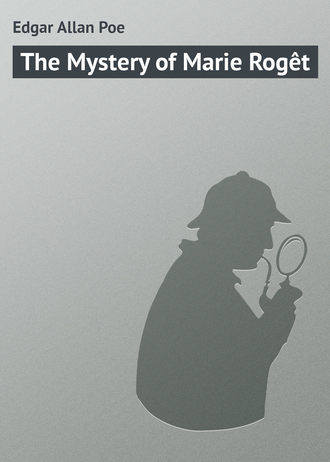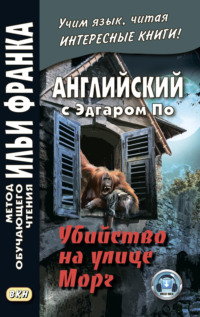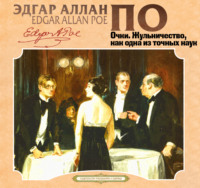 полная версия
полная версияThe Mystery of Marie Rogêt
By the following fact, some color was given to the suspicion thus thrown upon Beauvais. A visiter at his office, a few days prior to the girl’s disappearance, and during the absence of its occupant, had observed a rose in the key-hole of the door, and the name “Marie” inscribed upon a slate which hung near at hand.
The general impression, so far as we were enabled to glean it from the newspapers, seemed to be, that Marie had been the victim of a gang of desperadoes – that by these she had been borne across the river, maltreated and murdered. Le Commerciel[9], however, a print of extensive influence, was earnest in combating this popular idea. I quote a passage or two from its columns:
“We are persuaded that pursuit has hitherto been on a false scent, so far as it has been directed to the Barrière du Roule. It is impossible that a person so well known to thousands as this young woman was, should have passed three blocks without some one having seen her; and any one who saw her would have remembered it, for she interested all who knew her. It was when the streets were full of people, when she went out. . It is impossible that she could have gone to the Barrière du Roule, or to the Rue des Drômes, without being recognized by a dozen persons; yet no one has come forward who saw her outside of her mother’s door, and there is no evidence, except the testimony concerning her expressed intentions, that she did go out at all. Her gown was torn, bound round her, and tied; and by that the body was carried as a bundle. If the murder had been committed at the Barrière du Roule, there would have been no necessity for any such arrangement. The fact that the body was found floating near the Barrière, is no proof as to where it was thrown into the water…. A piece of one of the unfortunate girl’s petticoats, two feet long and one foot wide, was torn out and tied under her chin around the back of her head, probably to prevent screams. This was done by fellows who had no pocket-handkerchief.”
A day or two before the Prefect called upon us, however, some important information reached the police, which seemed to overthrow, at least, the chief portion of Le Commerciel’s argument. Two small boys, sons of a Madame Deluc, while roaming among the woods near the Barrière du Roule, chanced to penetrate a close thicket, within which were three or four large stones, forming a kind of seat, with a back and footstool. On the upper stone lay a white petticoat; on the second a silk scarf. A parasol, gloves, and a pocket-handkerchief were also here found. The handkerchief bore the name “Marie Rogêt.” Fragments of dress were discovered on the brambles around. The earth was trampled, the bushes were broken, and there was every evidence of a struggle. Between the thicket and the river, the fences were found taken down, and the ground bore evidence of some heavy burthen having been dragged along it.
A weekly paper, Le Soleil[10], had the following comments upon this discovery – comments which merely echoed the sentiment of the whole Parisian press:
“The things had all evidently been there at least three or four weeks; they were all mildewed down hard with the action of the rain and stuck together from mildew. The grass had grown around and over some of them. The silk on the parasol was strong, but the threads of it were run together within. The upper part, where it had been doubled and folded, was all mildewed and rotten, and tore on its being opened. . The pieces of her frock torn out by the bushes were about three inches wide and six inches long. One part was the hem of the frock, and it had been mended; the other piece was part of the skirt, not the hem. They looked like strips torn off, and were on the thorn bush, about a foot from the ground. . There can be no doubt, therefore, that the spot of this appalling outrage has been discovered.”
Consequent upon this discovery, new evidence appeared. Madame Deluc testified that she keeps a roadside inn not far from the bank of the river, opposite the Barrière du Roule. The neighborhood is secluded – particularly so. It is the usual Sunday resort of blackguards from the city, who cross the river in boats. About three o’clock, in the afternoon of the Sunday in question, a young girl arrived at the inn, accompanied by a young man of dark complexion. The two remained here for some time. On their departure, they took the road to some thick woods in the vicinity. Madame Deluc’s attention was called to the dress worn by the girl, on account of its resemblance to one worn by a deceased relative. A scarf was particularly noticed. Soon after the departure of the couple, a gang of miscreants made their appearance, behaved boisterously, ate and drank without making payment, followed in the route of the young man and girl, returned to the inn about dusk, and re-crossed the river as if in great haste.
It was soon after dark, upon this same evening, that Madame Deluc, as well as her eldest son, heard the screams of a female in the vicinity of the inn. The screams were violent but brief. Madame D. recognized not only the scarf which was found in the thicket, but the dress which was discovered upon the corpse. An omnibus driver, Valence[11], now also testified that he saw Marie Rogêt cross a ferry on the Seine, on the Sunday in question, in company with a young man of dark complexion. He, Valence, knew Marie, and could not be mistaken in her identity. The articles found in the thicket were fully identified by the relatives of Marie.
The items of evidence and information thus collected by myself, from the newspapers, at the suggestion of Dupin, embraced only one more point – but this was a point of seemingly vast consequence. It appears that, immediately after the discovery of the clothes as above described, the lifeless, or nearly lifeless body of St. Eustache, Marie’s betrothed, was found in the vicinity of what all now supposed the scene of the outrage. A phial labelled “laudanum,” and emptied, was found near him. His breath gave evidence of the poison. He died without speaking. Upon his person was found a letter, briefly stating his love for Marie, with his design of self-destruction.
“I need scarcely tell you,” said Dupin, as he finished the perusal of my notes, “that this is a far more intricate case than that of the Rue Morgue; from which it differs in one important respect. This is an ordinary, although an atrocious instance of crime. There is nothing peculiarly outré about it. You will observe that, for this reason, the mystery has been considered easy, when, for this reason, it should have been considered difficult, of solution. Thus; at first, it was thought unnecessary to offer a reward. The myrmidons of G – were able at once to comprehend how and why such an atrocity might have been committed. They could picture to their imaginations a mode – many modes – and a motive – many motives; and because it was not impossible that either of these numerous modes and motives could have been the actual one, they have taken it for granted that one of them must. But the case with which these variable fancies were entertained, and the very plausibility which each assumed, should have been understood as indicative rather of the difficulties than of the facilities which must attend elucidation. I have before observed that it is by prominences above the plane of the ordinary, that reason feels her way, if at all, in her search for the true, and that the proper question in cases such as this, is not so much ‘what has occurred?’ as ‘what has occurred that has never occurred before?’ In the investigations at the house of Madame L’Espanaye[12], the agents of G – were discouraged and confounded by that very unusualness which, to a properly regulated intellect, would have afforded the surest omen of success; while this same intellect might have been plunged in despair at the ordinary character of all that met the eye in the case of the perfumery-girl, and yet told of nothing but easy triumph to the functionaries of the Prefecture.
“In the case of Madame L’Espanaye and her daughter there was, even at the beginning of our investigation, no doubt that murder had been committed. The idea of suicide was excluded at once. Here, too, we are freed, at the commencement, from all supposition of self-murder. The body found at the Barrière du Roule, was found under such circumstances as to leave us no room for embarrassment upon this important point. But it has been suggested that the corpse discovered, is not that of the Marie Rogêt for the conviction of whose assassin, or assassins, the reward is offered, and respecting whom, solely, our agreement has been arranged with the Prefect. We both know this gentleman well. It will not do to trust him too far. If, dating our inquiries from the body found, and thence tracing a murderer, we yet discover this body to be that of some other individual than Marie; or, if starting from the living Marie, we find her, yet find her unassassinated – in either case we lose our labor; since it is Monsieur G – with whom we have to deal. For our own purpose, therefore, if not for the purpose of justice, it is indispensable that our first step should be the determination of the identity of the corpse with the Marie Rogêt who is missing.
“With the public the arguments of L’Etoile have had weight; and that the journal itself is convinced of their importance would appear from the manner in which it commences one of its essays upon the subject—’Several of the morning papers of the day,’ it says, ‘speak of the conclusive article in Monday’s Etoile.’ To me, this article appears conclusive of little beyond the zeal of its inditer. We should bear in mind that, in general, it is the object of our newspapers rather to create a sensation – to make a point – than to further the cause of truth. The latter end is only pursued when it seems coincident with the former. The print which merely falls in with ordinary opinion (however well founded this opinion may be) earns for itself no credit with the mob. The mass of the people regard as profound only him who suggests pungent contradictions of the general idea. In ratiocination, not less than in literature, it is the epigram which is the most immediately and the most universally appreciated. In both, it is of the lowest order of merit.
“What I mean to say is, that it is the mingled epigram and melodrame of the idea, that Marie Rogêt still lives, rather than any true plausibility in this idea, which have suggested it to L’Etoile, and secured it a favorable reception with the public. Let us examine the heads of this journal’s argument; endeavoring to avoid the incoherence with which it is originally set forth.
“The first aim of the writer is to show, from the brevity of the interval between Marie’s disappearance and the finding of the floating corpse, that this corpse cannot be that of Marie. The reduction of this interval to its smallest possible dimension, becomes thus, at once, an object with the reasoner. In the rash pursuit of this object, he rushes into mere assumption at the outset. ‘It is folly to suppose,’ he says, ‘that the murder, if murder was committed on her body, could have been consummated soon enough to have enabled her murderers to throw the body into the river before midnight.’ We demand at once, and very naturally, why? Why is it folly to suppose that the murder was committed within five minutes after the girl’s quitting her mother’s house? Why is it folly to suppose that the murder was committed at any given period of the day? There have been assassinations at all hours. But, had the murder taken place at any moment between nine o’clock in the morning of Sunday, and a quarter before midnight, there would still have been time enough ‘to throw the body into the river before midnight.’ This assumption, then, amounts precisely to this – that the murder was not committed on Sunday at all – and, if we allow L’Etoile to assume this, we may permit it any liberties whatever. The paragraph beginning ‘It is folly to suppose that the murder, etc.,’ however it appears as printed in L’Etoile, may be imagined to have existed actually thus in the brain of its inditer—‘It is folly to suppose that the murder, if murder was committed on the body, could have been committed soon enough to have enabled her murderers to throw the body into the river before midnight; it is folly, we say, to suppose all this, and to suppose at the same time, (as we are resolved to suppose,) that the body was not thrown in until after midnight’—a sentence sufficiently inconsequential in itself, but not so utterly preposterous as the one printed.
“Were it my purpose,” continued Dupin, “merely to make out a case against this passage of L’Etoile’s argument, I might safely leave it where it is. It is not, however, with L’Etoile that we have to do, but with the truth. The sentence in question has but one meaning, as it stands; and this meaning I have fairly stated: but it is material that we go behind the mere words, for an idea which these words have obviously intended, and failed to convey. It was the design of the journalist to say that, at whatever period of the day or night of Sunday this murder was committed, it was improbable that the assassins would have ventured to bear the corpse to the river before midnight. And herein lies, really, the assumption of which I complain. It is assumed that the murder was committed at such a position, and under such circumstances, that the bearing it to the river became necessary. Now, the assassination might have taken place upon the river’s brink, or on the river itself; and, thus, the throwing the corpse in the water might have been resorted to, at any period of the day or night, as the most obvious and most immediate mode of disposal. You will understand that I suggest nothing here as probable, or as cöincident with my own opinion. My design, so far, has no reference to the facts of the case. I wish merely to caution you against the whole tone of L’Etoile’s suggestion, by calling your attention to its ex-parte character at the outset.
“Having prescribed thus a limit to suit its own preconceived notions; having assumed that, if this were the body of Marie, it could have been in the water but a very brief time; the journal goes on to say:
‘All experience has shown that drowned bodies, or bodies thrown into the water immediately after death by violence, require from six to ten days for sufficient decomposition to take place to bring them to the top of the water. Even when a cannon is fired over a corpse, and it rises before at least five or six days’ immersion, it sinks again if let alone.’
“These assertions have been tacitly received by every paper in Paris, with the exception of Le Moniteur[13]. This latter print endeavors to combat that portion of the paragraph which has reference to ‘drowned bodies’ only, by citing some five or six instances in which the bodies of individuals known to be drowned were found floating after the lapse of less time than is insisted upon by L’Etoile. But there is something excessively unphilosophical in the attempt on the part of Le Moniteur, to rebut the general assertion of L’Etoile, by a citation of particular instances militating against that assertion. Had it been possible to adduce fifty instead of five examples of bodies found floating at the end of two or three days, these fifty examples could still have been properly regarded only as exceptions to L’Etoile’s rule, until such time as the rule itself should be confuted. Admitting the rule, (and this Le Moniteur does not deny, insisting merely upon its exceptions,) the argument of L’Etoile is suffered to remain in full force; for this argument does not pretend to involve more than a question of the probability of the body having risen to the surface in less than three days; and this probability will be in favor of L’Etoile’s position until the instances so childishly adduced shall be sufficient in number to establish an antagonistical rule.
“You will see at once that all argument upon this head should be urged, if at all, against the rule itself; and for this end we must examine the rationale of the rule. Now the human body, in general, is neither much lighter nor much heavier than the water of the Seine; that is to say, the specific gravity of the human body, in its natural condition, is about equal to the bulk of fresh water which it displaces. The bodies of fat and fleshy persons, with small bones, and of women generally, are lighter than those of the lean and large-boned, and of men; and the specific gravity of the water of a river is somewhat influenced by the presence of the tide from sea. But, leaving this tide out of question, it may be said that very few human bodies will sink at all, even in fresh water, of their own accord. Almost any one, falling into a river, will be enabled to float, if he suffer the specific gravity of the water fairly to be adduced in comparison with his own – that is to say, if he suffer his whole person to be immersed, with as little exception as possible. The proper position for one who cannot swim, is the upright position of the walker on land, with the head thrown fully back, and immersed; the mouth and nostrils alone remaining above the surface. Thus circumstanced, we shall find that we float without difficulty and without exertion. It is evident, however, that the gravities of the body, and of the bulk of water displaced, are very nicely balanced, and that a trifle will cause either to preponderate. An arm, for instance, uplifted from the water, and thus deprived of its support, is an additional weight sufficient to immerse the whole head, while the accidental aid of the smallest piece of timber will enable us to elevate the head so as to look about. Now, in the struggles of one unused to swimming, the arms are invariably thrown upwards, while an attempt is made to keep the head in its usual perpendicular position. The result is the immersion of the mouth and nostrils, and the inception, during efforts to breathe while beneath the surface, of water into the lungs. Much is also received into the stomach, and the whole body becomes heavier by the difference between the weight of the air originally distending these cavities, and that of the fluid which now fills them. This difference is sufficient to cause the body to sink, as a general rule; but is insufficient in the cases of individuals with small bones and an abnormal quantity of flaccid or fatty matter. Such individuals float even after drowning.
“The corpse, being supposed at the bottom of the river, will there remain until, by some means, its specific gravity again becomes less than that of the bulk of water which it displaces. This effect is brought about by decomposition, or otherwise. The result of decomposition is the generation of gas, distending the cellular tissues and all the cavities, and giving the puffed appearance which is so horrible. When this distension has so far progressed that the bulk of the corpse is materially increased without a corresponding increase of mass or weight, its specific gravity becomes less than that of the water displaced, and it forthwith makes its appearance at the surface. But decomposition is modified by innumerable circumstances – is hastened or retarded by innumerable agencies; for example, by the heat or cold of the season, by the mineral impregnation or purity of the water, by its depth or shallowness, by its currency or stagnation, by the temperament of the body, by its infection or freedom from disease before death. Thus it is evident that we can assign no period, with any thing like accuracy, at which the corpse shall rise through decomposition. Under certain conditions this result would be brought about within an hour; under others, it might not take place at all. There are chemical infusions by which the animal frame can be preserved forever from corruption; the Bi-chloride of Mercury is one. But, apart from decomposition, there may be, and very usually is, a generation of gas within the stomach, from the acetous fermentation of vegetable matter (or within other cavities from other causes) sufficient to induce a distension which will bring the body to the surface. The effect produced by the firing of a cannon is that of simple vibration. This may either loosen the corpse from the soft mud or ooze in which it is imbedded, thus permitting it to rise when other agencies have already prepared it for so doing; or it may overcome the tenacity of some putrescent portions of the cellular tissue; allowing the cavities to distend under the influence of the gas.
“Having thus before us the whole philosophy of this subject, we can easily test by it the assertions of L’Etoile. ‘All experience shows,’ says this paper, ‘that drowned bodies, or bodies thrown into the water immediately after death by violence, require from six to ten days for sufficient decomposition to take place to bring them to the top of the water. Even when a cannon is fired over a corpse, and it rises before at least five or six days’ immersion, it sinks again if let alone.’
“The whole of this paragraph must now appear a tissue of inconsequence and incoherence. All experience does not show that ‘drowned bodies’ require from six to ten days for sufficient decomposition to take place to bring them to the surface. Both science and experience show that the period of their rising is, and necessarily must be, indeterminate. If, moreover, a body has risen to the surface through firing of cannon, it will not ‘sink again if let alone,’ until decomposition has so far progressed as to permit the escape of the generated gas. But I wish to call your attention to the distinction which is made between ‘drowned bodies,’ and ‘bodies thrown into the water immediately after death by violence.’ Although the writer admits the distinction, he yet includes them all in the same category. I have shown how it is that the body of a drowning man becomes specifically heavier than its bulk of water, and that he would not sink at all, except for the struggles by which he elevates his arms above the surface, and his gasps for breath while beneath the surface – gasps which supply by water the place of the original air in the lungs. But these struggles and these gasps would not occur in the body ‘thrown into the water immediately after death by violence.’ Thus, in the latter instance, the body, as a general rule, would not sink at all – a fact of which L’Etoile is evidently ignorant. When decomposition had proceeded to a very great extent – when the flesh had in a great measure left the bones – then, indeed, but not till then, should we lose sight of the corpse.
“And now what are we to make of the argument, that the body found could not be that of Marie Rogêt, because, three days only having elapsed, this body was found floating? If drowned, being a woman, she might never have sunk; or having sunk, might have reappeared in twenty-four hours, or less. But no one supposes her to have been drowned; and, dying before being thrown into the river, she might have been found floating at any period afterwards whatever.
“‘But,’ says L’Etoile, ‘if the body had been kept in its mangled state on shore until Tuesday night, some trace would be found on shore of the murderers.’ Here it is at first difficult to perceive the intention of the reasoner. He means to anticipate what he imagines would be an objection to his theory – viz.: that the body was kept on shore two days, suffering rapid decomposition – more rapid than if immersed in water. He supposes that, had this been the case, it might have appeared at the surface on the Wednesday, and thinks that only under such circumstances it could so have appeared. He is accordingly in haste to show that it was not kept on shore; for, if so, ‘some trace would be found on shore of the murderers.’ I presume you smile at the sequitur. You cannot be made to see how the mere duration of the corpse on the shore could operate to multiply traces of the assassins. Nor can I.
“‘And furthermore it is exceedingly improbable,’ continues our journal, ‘that any villains who had committed such a murder as is here supposed, would have thrown the body in without weight to sink it, when such a precaution could have so easily been taken.’ Observe, here, the laughable confusion of thought! No one – not even L’Etoile – disputes the murder committed on the body found. The marks of violence are too obvious. It is our reasoner’s object merely to show that this body is not Marie’s. He wishes to prove that Marie is not assassinated – not that the corpse was not. Yet his observation proves only the latter point. Here is a corpse without weight attached. Murderers, casting it in, would not have failed to attach a weight. Therefore it was not thrown in by murderers. This is all which is proved, if any thing is. The question of identity is not even approached, and L’Etoile has been at great pains merely to gainsay now what it has admitted only a moment before. ‘We are perfectly convinced,’ it says, ‘that the body found was that of a murdered female.’











